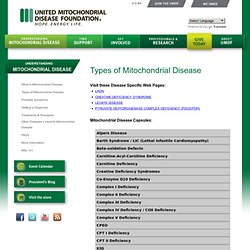

Home - The United Mitochondrial Disease Foundation. What is Mitochondrial Disease - The United Mitochondrial Disease Foundation. Mitochondrial diseases result from failures of the mitochondria, specialized compartments present in every cell of the body except red blood cells.

Mitochondria are responsible for creating more than 90% of the energy needed by the body to sustain life and support growth. When they fail, less and less energy is generated within the cell. Cell injury and even cell death follow. If this process is repeated throughout the body, whole systems begin to fail, and the life of the person in whom this is happening is severely compromised. The disease primarily affects children, but adult onset is becoming more and more common. Diseases of the mitochondria appear to cause the most damage to cells of the brain, heart, liver, skeletal muscles, kidney and the endocrine and respiratory systems. Energy Factories and Much More The conventional teaching in biology and medicine is that mitochondria function only as "energy factories" for the cell.
Membranes and the diseases within. Membranes and the diseases within Sophie Petit-Zeman The concept of a 'true' membrane disorder is differs from other disease classes as many diseases involve the membrane to some degree.

Enclosing and compartmentalizing both entire cells and the organelles within them, it is unsurprising that the disruption of membrane function has diverse pathological consequences. From their role in regulating transport in and out of cells or subcellular domains, conferring selective receptivity via protein receptors, anchoring cytoskeletal filaments or components of the extracellular matrix, providing sites for enzyme binding and catalysis, and allowing directed cell or organelle motility, when membranes go wrong, much else can too. Lysosomal Disease Network. Types of Mitochondrial Disease - The United Mitochondrial Disease Foundation.
Long Name: Mitochondrial Encephalomyopathy Lactic Acidosis and Strokelike Episodes.

Symptoms: Short statue, seizures, stroke-like episodes with focused neurological deficits, recurrent headaches, cognitive regression, disease progression, ragged-red fibers. Cause: Mitochondrial DNA point mutations: A3243G (most common) MELAS - Mitochondrial Myopathy (muscle weakness), Encephalopathy (brain and central nervous system disease), Lactic Acidosis (buildup of a cell waste product), and Stroke-like Episodes (partial paralysis, partial vision loss, or other neurological abnormalities) MELAS is a progressive neurodegenerative disorder with typical onset between the ages of 2 and 15, although it may occur in infancy or as late as adulthood. Initial symptoms may include stroke-like episodes, seizures, migraine headaches, and recurrent vomiting.
Usually, the patient appears normal during infancy, although short stature is common. There is no cure or specific treatment for MELAS. Diseases of the Nuclear Envelope. Parkinson's disease may be caused by microtubule, rather than mitochondrial complex I, dysfunction. Patients with Parkinson's disease (PD) suffer a specific loss of dopaminergic neurons from the midbrain region that controls motor function.

The exact mechanism of this selective neurodegeneration is unclear, though many lines of evidence point to dysfunctional mitochondrial complex I as one root cause of the disease. Yet new research now suggests that defective regulation of microtubules may be responsible for at least some cases of PD. The study appears in the March 7 issue of The Journal of Cell Biology. Mitochondria were first implicated in PD when drug users in California developed Parkinson's-like symptoms due to a contaminant in their heroin supply called MPTP. This chemical is metabolized in the brain into MPP+, a compound that blocks oxidative phosphorylation by inhibiting mitochondrial complex I.
"We didn't set out to prove anybody wrong," says Xia. This suggested that complex I inhibition is insufficient to cause dopaminergic nerve apoptosis. Membranes and the diseases within. The invisible disease that's killing our son. Lori and Neil Martin's son, Will, suffers from mitochondrial disease.

Every 30 minutes a child is born who will develop mitochondrial disease by age 10Mitochondria are responsible for creating more than 90% of our body's energy The disease primarily affects children, but adult onset is becoming more common (CNN) -- On July 5, 2011, my husband and I were told that our 2-year-old son has an invisible killer living inside his body.
Just a few short years ago, I was happily pregnant. Now, suddenly: Why? What? That invisible killer is called mitochondrial disease. We're one of the lucky ones. This silent killer is attacking our nation's children at an appalling rate. As a first-time mom, I had no idea that I should have been scared of mitochondria. Mitochondria are responsible for creating more than 90% of the energy needed by the body to sustain life and support growth. Mitochondrial disease is similar to cancer in the way it presents itself -- it can manifest in many forms. Foundation for Mitochondrial Medicine - Supporting Mitochondrial Disease Research and Treatments. Overview of Mitochondrial Disease Mitochondrial disease or dysfunction is an energy production problem.

Almost all cells in the body have mitochondria, which are tiny “power plants” that produce a body’s essential energy. Mitochondrial disease means the power plants in cells don’t function properly. When that happens, some functions in the body don’t work normally. It’s as if the body has a power failure: there is a gradation of effects, like a ‘brown out’ or a ‘black out’. Scientifically, it is actually a category or group of diseases.